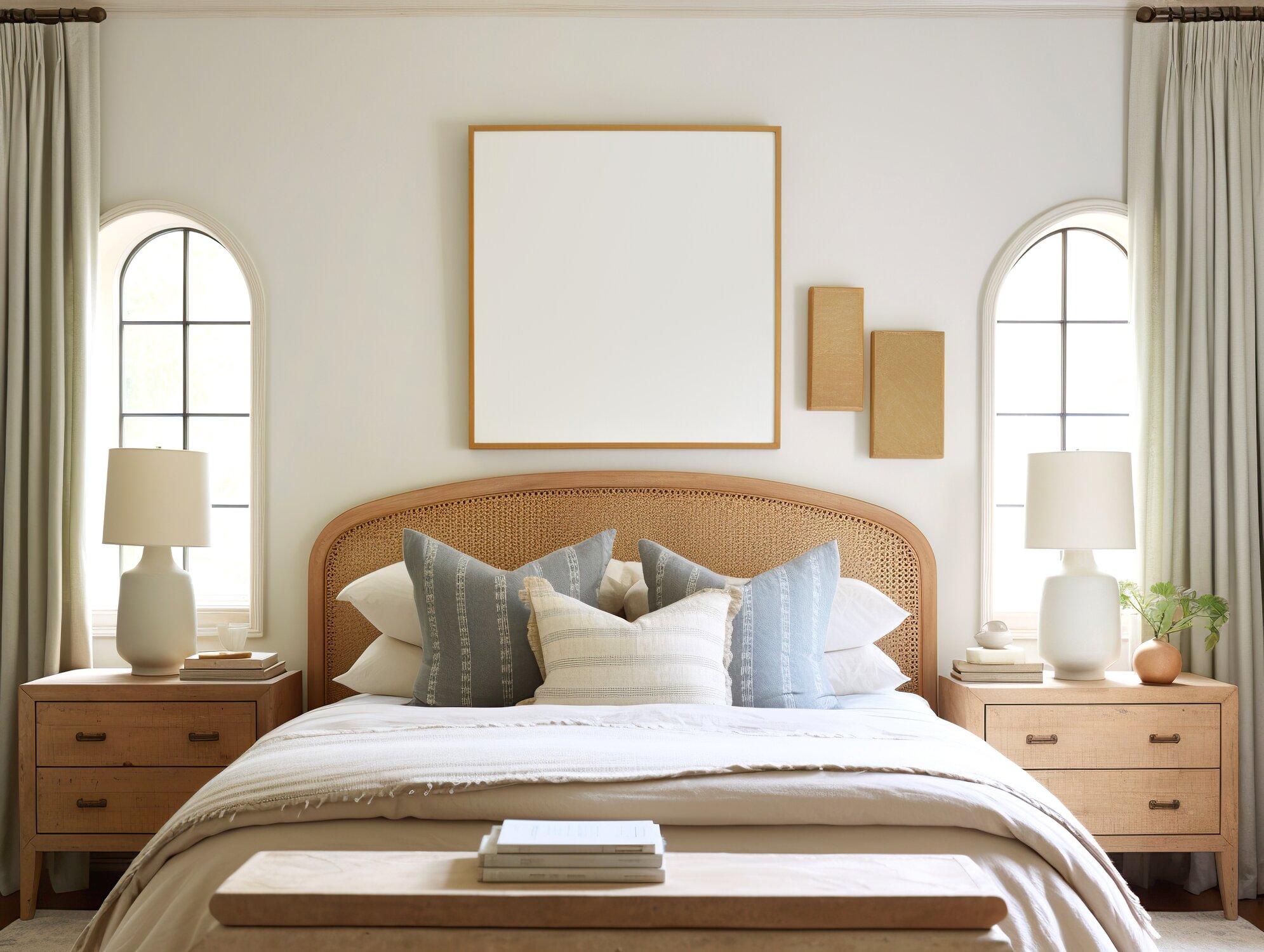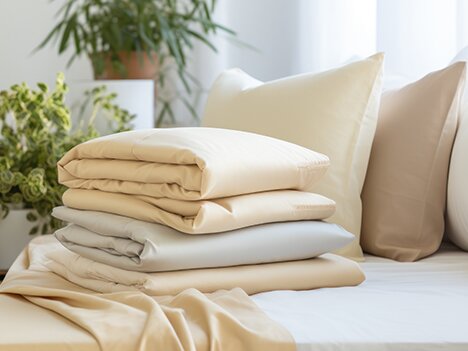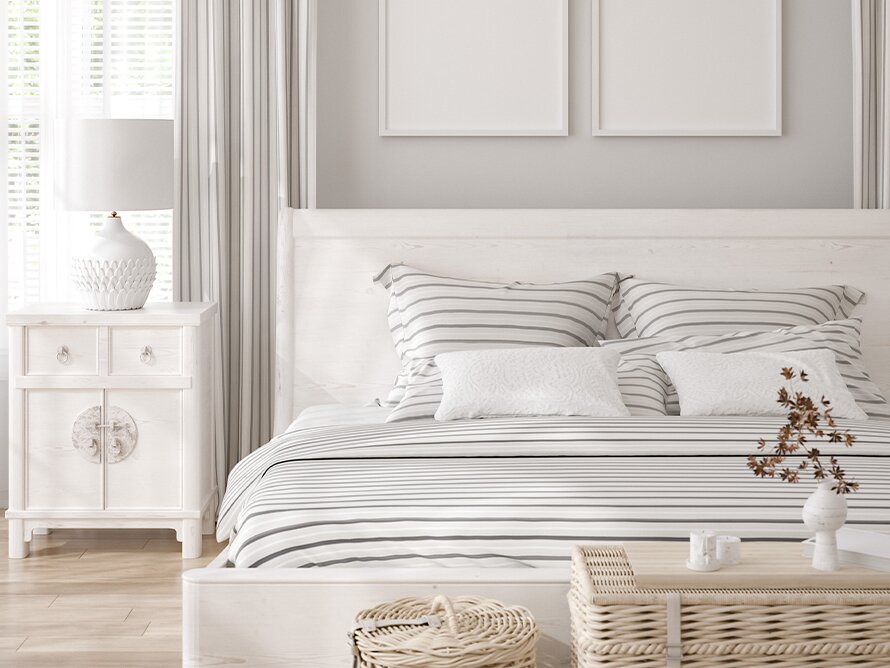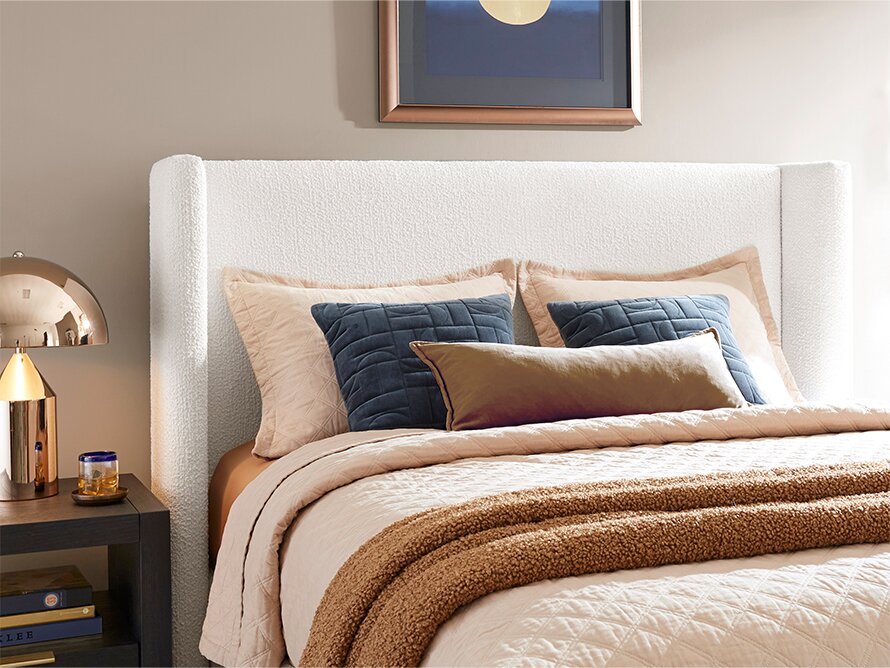How To Choose the Right Bedding for Your Bedroom
Your bedroom is your sanctuary, where all your worries dissolve during a restful night’s sleep. And having the right bedding can enhance this comfort and peace of mind, whether you prefer a thick and luxurious comforter or a thin, heat-wicking sheet. Here’s our guide to help you navigate all the different types of materials, weaves, thread counts, bedding choices, and styles for your perfect bedroom.
Shop all Bedding
How To Choose the Right Bed Sheets
Size
First, measure your mattress size and depth, including the added thickness from any mattress toppers and pads. There are over a dozen types of mattresses so it’s always wise to double-check these two measurements before purchasing bed sheets. A fitted sheet that’s too small or short won’t tuck neatly around all the mattress’s bottom edges whereas an overly big or wide sheet will leave extra fabric draping over the bed frame. Any loose fabric from an ill-fitting sheet can cause discomfort by bunching up as you move around throughout the night.
Basic sheet sets for full-size and larger mattresses include one fitted sheet, one flat sheet, and two pillowcases. Twin-size mattresses include the same, apart from providing only one pillowcase. There are options for all-inclusive sets, including a matching comforter and a set of shams.
Basic sheet sets for full-size and larger mattresses include one fitted sheet, one flat sheet, and two pillowcases. Twin-size mattresses include the same, apart from providing only one pillowcase. There are options for all-inclusive sets, including a matching comforter and a set of shams.
Materials
To instantly relax when setting off to sleep, you need bedding made from suitable materials. Whether you’re seeking extra softness, breathability, or durability, here are all the common fabrics and their unique upsides and downsides.
-
Cotton
PROS: Breathable. Easy to clean. Various types of cotton available.
CONS: Traps moisture. Can get expensive, depending on the thread count.
CONS: Traps moisture. Can get expensive, depending on the thread count.
-
Linen
PROS: Natural fibers. Antimicrobial. Moisture-wicking. Durable. Reasonable prices.
CONS: Naturally coarse, though it’s available in pre-washed sets and tends to softens after each wash.
CONS: Naturally coarse, though it’s available in pre-washed sets and tends to softens after each wash.
-
Polyester
PROS: Water- and wrinkle-resistant. Easy to clean. Affordable.
CONS: Stiffer feel. Less breathable than cotton. Difficult to remove oil and grease stains.
CONS: Stiffer feel. Less breathable than cotton. Difficult to remove oil and grease stains.
-
Polyester Blend/ Microfiber
PROS: Softer than polyester. Stain-resistant. Good choice for colder weather.
CONS: Less breathable than cotton. Prone to pilling.
CONS: Less breathable than cotton. Prone to pilling.
-
Bamboo
PROS: Softer than polyester and linen. Sustainable. Pest-resistant. Machine washable. Budget-friendly alternative to cotton.
CONS: Not hypoallergenic. Can shrink or get damaged if dried with high heat.
CONS: Not hypoallergenic. Can shrink or get damaged if dried with high heat.
-
Silk
PROS: Smooth and easy on skin and hair. Hypoallergenic. Temperature-regulating.
CONS: Wrinkles easily. Must be hand-washed and air-dried. High price point.
CONS: Wrinkles easily. Must be hand-washed and air-dried. High price point.
-
Flannel
PROS: Soft. Durable material. Good choice for colder weather. Affordable.
CONS: Traps moisture and heat.
CONS: Traps moisture and heat.
Weave
Beyond the thread count and characteristics of the fabric itself, how materials are woven together can play a big part in the quality of your sheets. Here are the most popular weaves and their construction process:
-
Percale
Used on cotton or cotton-polyester blend. It is a tight weave with a one-yarn over, one-yarn under technique. This weave gives sheets a crisp, matte finish.
-
Sateen
Giving you a soft and luxurious finish, sateen uses a weave that’s one yarn over and three yarns under. It’s not as durable as percale but it is warmer.
-
Twill
This weave is durable and used on flannel and wool. Made with two yarns over and two yarns under, it’s more affordable than sateen, but prone to shrinkage.
Thread count
Simply put, thread count is the number of threads in one square inch of the material. Though this number is often touted as the ultimate signifier of a bed sheet’s quality, designers rely more on the material and weave type. But that doesn’t mean thread count is unimportant. Here are some factors to consider when it comes to figuring out which thread count is right for you:
1.
Sheets with a lower thread count are less durable but more breathable than those with a higher count — an important distinction for anyone who gets overheated throughout the night.
2.
A higher thread count is better suited for durability and a soft touch. But it’s also more expensive.
3.
The optimal thread count for each type of material is different. For example, a higher thread count for cotton will make the sheets softer and more durable. But a high thread count for linen sheets would make them heavy and trap more heat. The best thread count for linen is 80–130.
4.
If the thread count exceeds 900, we recommend a little more research. See if the manufacturer uses double- or triple-ply fibers, which means they used cheaper materials that downgrade the quality and durability of the sheets.
How To Choose the Right Blankets
Blankets are used for everything from comfort to warmth to styling. Because of their versatile needs, blankets come in various forms: Comforters, duvets, throw blankets, and quilts.
Drop and Fill
When looking for the right blanket for your bed, we recommend considering the bedding's drop and fill.
Drop: The length of your blanket or comforter from the top of your mattress to the floor, affecting the coverage and style of your bedding. You want to ensure that your blanket or comforter has enough fabric to cover your bed and hang over the sides.
Fill: The amount of stuffing in your comforter, affecting the warmth and weight of your bedding. You want to choose a fill that suits your climate and preference, such as down, feathers, cotton, wool, or polyester.
Fill: The amount of stuffing in your comforter, affecting the warmth and weight of your bedding. You want to choose a fill that suits your climate and preference, such as down, feathers, cotton, wool, or polyester.
Comforter or Duvet
A comforter and duvet are the perfect bedding piece to keep you warm through cold nights. Both blankets are available in all mattress sizes. Comforters and duvets serve similar purposes but have a few differences:
While a comforter is a single piece, a duvet consists of an insert and a cover.
Most comforters are machine washable, but some are not. But with the duvet’s cover, you can easily take it off and throw it into the wash.
A comforter is a ready-to-go styling piece, but the duvet’s cover can be swapped out when styles and designs change.
Most comforters are machine washable, but some are not. But with the duvet’s cover, you can easily take it off and throw it into the wash.
A comforter is a ready-to-go styling piece, but the duvet’s cover can be swapped out when styles and designs change.
Throw Blankets
Sometimes simply called a throw, throw blankets are a smaller bedding that only one person can use at a time. When it comes to the bedroom, throws are helpful as decor to spruce up your room. They are a perfect piece to help you cuddle up in the living room when you’re not quite ready to get into bed. Throws can also serve as a picnic blanket or a portable reminder of home when traveling with kids.
Shop throw blankets
Quilts
Quilts are great transitional blankets in the spring and fall, and they are perfect for hot sleepers. Every quilt has three layers stitched together: the top and bottom are made of fabric, while the middle is a filling made of cotton, wool, or polyester. They come in different sizes, patterns, and designs that can either add coziness or pizzazz to the room.
Shop quilts
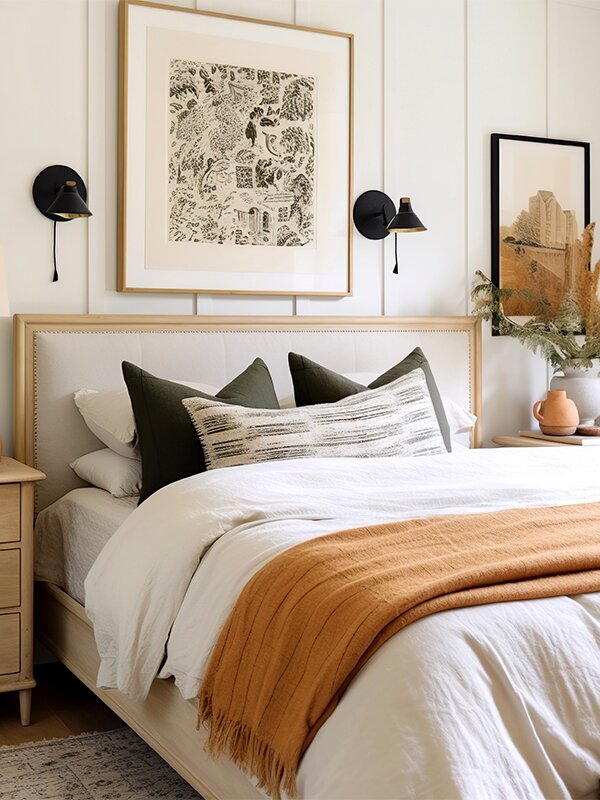

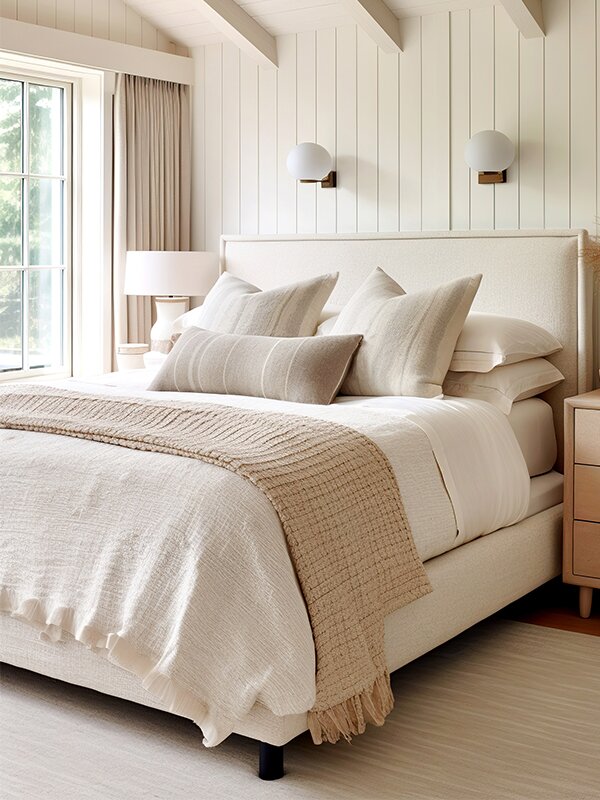
Bedding Ideas That Complement Your Style
Now that you have chosen the ideal type of bedding for your best sleep, it’s time to start thinking about the design. In general, you want to ensure your bedding will complement the style you’ve already established in your room. Be mindful of how patterns, scale, and proportions can bring balance to your room. Here are some common bedding themes to explore:
Clean & Classic
Choose an all-white bed sheet set, comforter or duvet, pillows, and shams to get a hotel-style luxury feel whenever you walk into your room.
Playful Patterns
Show off your fun side by adding patterns like a striped bed sheet, a comforter or duvet cover with medallion patterns, or pillows with geometric shapes.
Mix Up Materials
Instead of choosing a unified bed sheet set, pair cotton sheets and a knitted Afghan. Or use silk pillowcases with your cotton or linen bed sheet.
One Color, All Shades
Find cohesion without being matchy matchy. Pick your favorite color for your bed sheets, like blue for calm, yellow and oranges for positivity, or purple to uplift your spirits. Then add blankets and pillows in different shades of the same color.
Pop of Color
Want to stay simple but still add character to your bedding? Add an accent color with a throw blanket, throw pillows, or bedding with seams for a subtle statement.
Seasonal Refresh
If your room decor changes with the seasons, let your bedding come along. Choose light and airy percale cotton, bamboo, or silk bedding for the spring and summer, then switch to warm and cozy flannel, poly-blend, microfiber, and jersey bedding when the temperature dips.
Discover Your Perfect Bedding at Furniture.com
Having the right bedding for style and function is key to a balanced bedroom. If you’re ready to start searching, browse our online store or find a store location closest to you.
Shop all Bedding
